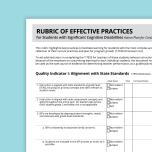Alignment to State Standards: Involving Young Students in the IEP Process
In this video, Ayo Jones discusses ways to involve young students in the IEP process. This video aligns with the Rubric of Effective Practices Quality Indicator I: Alignment to State Standards.


